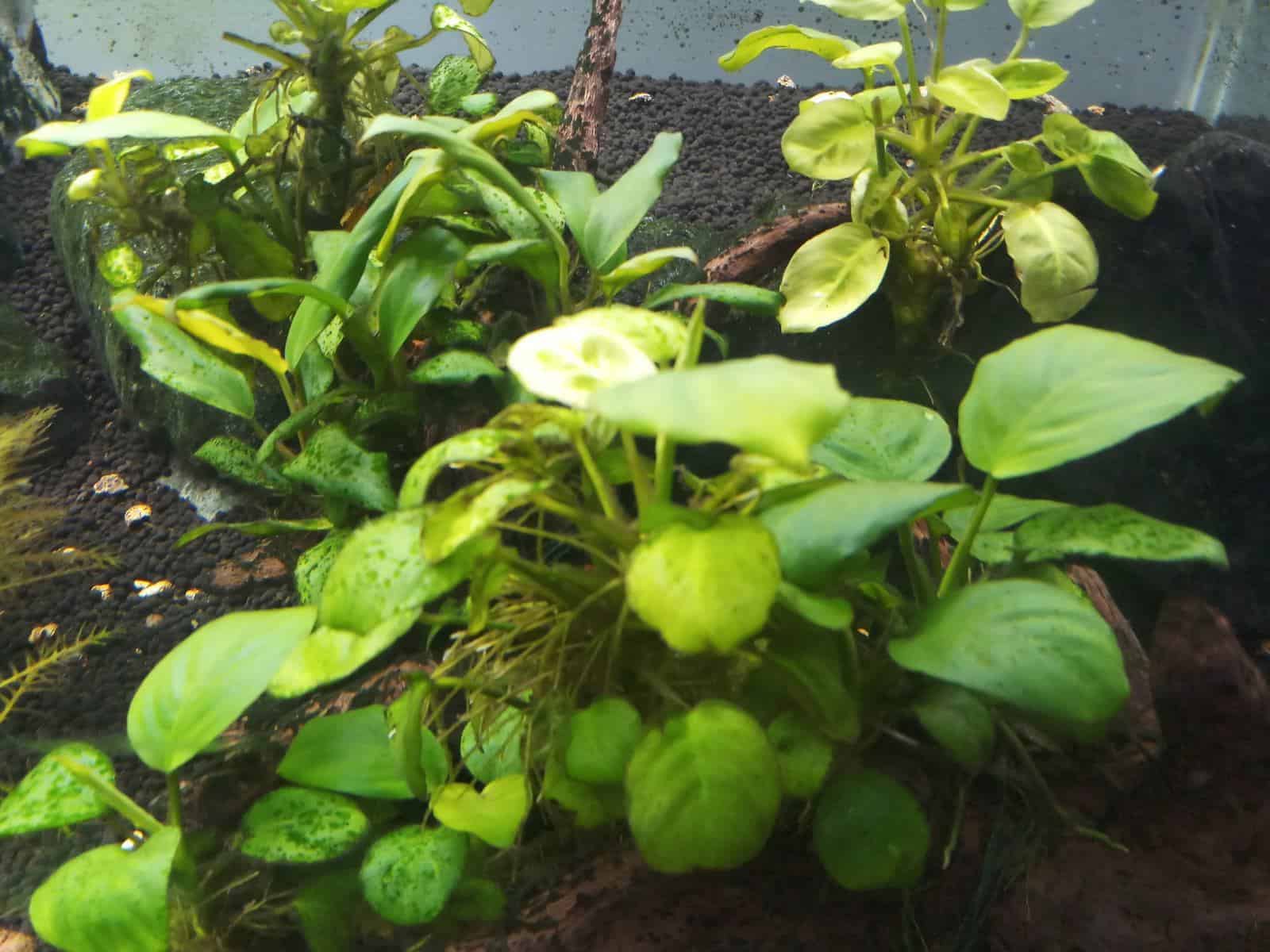As aquarium specialists, we know how concerning it can be to see any kind of algae bloom in your aquarium. Brown algae may look particularly unsightly, but thankfully, it’s one of the easier types of algae to control.
A well-cycled tank, good aquarium maintenance, and clean water are your best friends when it comes to removing brown algae. Here, we’ll show you how.
Key Takeaways
- Brown aquarium algae is a type of diatom that covers rocks, plants, and substrates in a rusty-colored coating.
- These diatoms typically proliferate in uncycled aquariums or when water parameters are particularly poor. Improving water conditions is the key to removing brown algae.
- If brown algae persists, it may indicate an issue with your tap water or tank substrate.
What Is Brown Algae?
Brown algae can be pretty easily identified from red (Rhodophyta) or green (Chlorophyta) algae, though the exact species that you’re dealing with can only be told by looking under a microscope.
True brown algae is a member of Phaeophyta, though is not found in the aquarium hobby; this kind of brown algae can be found throughout the cooler waters of North America and make up some of the largest kelp forests.
So, what does brown algae refer to in the aquarium hobby?
Diatoms
More often than not, when someone says that your tank is struggling with brown algae, they mean that you have a diatom problem. Diatoms are an essential part of aquatic ecosystems and are responsible for supplying most of the available oxygen on the planet.
These single-celled algae have cell walls that are made out of silica, which helps protect them against pathogens. They are planktonic and their movement depends on the currents in rivers and oceans. In the aquarium, they cannot freely float for long and they get caught on plants and substrates, covering these objects in a rust-colored mat.
What Does Brown Algae Look Like?

Brown algae makes things look dirty. You might start to notice patches of rust-colored fuzz on decorations, plants, and the substrate. As long as this algae doesn’t start to grow thick and clumpy and/or change color, it is safe to say that your algae problem is simply diatoms.
Is Brown Algae in an Aquarium Good or Bad?
While brown algae isn’t good for the aquarium, it isn’t necessarily bad either. As mentioned before, diatoms have a silica cell wall; this means that they need a constant source of silicates to repair their structures and to reproduce.
Most aquariums only have a limited amount of silicate available in them, and diatoms usually disappear on their own within a matter of days or a couple of weeks.
However, if you have a persistent diatom problem, then this brown algae could be a sign of a serious underlying problem, which we’ll discuss more later.
What Causes Brown Algae in Fish Tanks?
There are a few reasons why these patches of rust might be turning up in your aquarium. The most common reason is that the tank was newly set up, but it could also be the result of poor tap water quality, certain substrates, or light and nutrient imbalances.
New Tank Setup
For the first few months of running an aquarium, there is no telling what your tank is going to do next; parameters are volatile, and water cloudiness changes from day to day.
However, it is during this time that loads of beneficial bacteria populations establish themselves and gradually work towards creating that ideal stability.
The problem is that this beneficial bacteria takes time to colonize enough to take up all the extra nutrients that are available in the water column. This means that more opportunistic species, like brown algae, can come in and thrive; though only for as long as there is enough silicate for them to live on.
For a couple of days or a week or two, diatoms take over most surfaces in the aquarium, taking up nutrients that the beneficial bacteria cannot process fast enough. But once the silicate is depleted from the system, the diatoms leave.
It isn’t likely that they’ll return unless you’re struggling with any of the other following causes.
Does Brown Algae Mean Your Tank Is Cycled?
While a brown algae outbreak does not mean that your tank is cycled, it definitely means that you’re well on your way.
Annoying as algae outbreaks might seem, they are a sure sign that biological processes are underway in your tank and that soon enough you will be able to add the fish and invertebrates of your dreams!
Tap Water Quality
Water changes are essential for good fish tank maintenance; they remove excess and depleted nutrients while introducing new trace elements and fresh oxygen.
Most freshwater hobbyists like to use tap water as most of the essential minerals are already present. However, tap water is notorious for having a lot of unknowns, and it is usually safe to assume that some amount of phosphates is entering the system through water changes.
Without having a silicate test kit or a full analysis of your public water done, there is no way of telling the level of silicates in your tap water. This means that as long as you use this water, there is always a chance that brown algae will make an appearance in your tank.
Many saltwater hobbyists default to using distilled water or reverse osmosis (RO) water to lessen the likelihood that such impurities will make their way into the system. Though this might take some extra work, it might be the best option for avoiding algae in the future.
Substrates
While substrates don’t usually cause any problems, some have been known to leak silicates into the water. Silica is the main component of sand found across the world, which means that there’s a pretty big chance that it’s in your substrate as well.
If you’ve recently changed your substrate and diatoms start showing up, this might be something to consider. Otherwise, as long as the substrate is labeled as being aquarium-safe and has trustworthy reviews, then you should have no problems with excess silicates in your system.
Nutrient Imbalances
It’s well known that light and nutrient imbalances are responsible for most algae problems, and diatoms are no different. In addition to silica, brown algae needs nitrates and phosphates to truly thrive in the aquarium.
In both freshwater and saltwater aquariums, nitrates and phosphates are essential nutrients that plants and other organisms need to fulfill biological functions.
While you need to keep ammonia and nitrites at 0 ppm, you need traceable amounts of both phosphate and nitrate in your system, especially if you have live plants. However, when these nutrients aren’t being absorbed fast enough or too much is entering the system in large doses, then brown, red, and green algae can start to outcompete the live plants and corals.
Just like silicates can enter the tank through tap water, both nitrates and phosphates can also come in via water changes. If you find that brown, red, and/or green algae are regularly popping up in your tank and there’s no other probable explanation, then be sure to test your tap water.
Aquarium Lighting
Along with nutrients, excess lighting is a big catalyst for algae growth. However, there is some debate in the fishkeeping hobby about whether diatoms thrive in high or low-light settings.
One side believes that diatoms populate faster in low light conditions because they can outcompete many other light-hungry types of red and green algae, as well as the live plants in your aquarium.
The other side believes that diatoms are efficient photosynthetic algae that grow and spread the fastest under longer and more intense lighting conditions.
You may get advice that a temporary blackout for your tank will help in getting rid of the diatoms, but we suggest just waiting it out.
How Do You Get Rid of Brown Algae in a Fish Tank?
Out of all the red and green algae species, brown algae is probably the easiest to remove. Diatoms are usually found in newly set up fish tanks as they feast on the available silicates and other excess nutrients in the aquarium. However, once these are depleted, the diatoms can no longer grow.
But if you’re facing a chronic outbreak of brown algae that never seems to leave, how can you get rid of it forever?
Tank Maintenance
One of the best ways to remove brown algae, green algae, red algae, or any other mystery types of algae that find their way into our fish tanks is by devoting a little extra time to maintenance. A brown algae problem stems from poor water parameters, which can often be fixed with just a succession of regular water changes with good quality source water.
At the same time, you will want to remove decorations and plants that have been covered in diatoms and gently scrub them in an external container; this will keep spores from spreading and possibly coming back even stronger in other areas of your tank.
If you have diatoms covering the substrate, you will also want to make sure to vacuum and suck up any particles that float into the water column.
Livestock
While some fish and invertebrates will eat brown algae, they should never be used as a substitute for consistent tank maintenance!
However, if you have the tank space and are looking to get some algae eaters to add to your cleanup crew, then there are a few species that will take care of diatoms specifically.
For snails, ramshorn snails (Planorbidae family) and nerite snails (Neritidae family) tackle uneaten food, and decaying plant leaves, and even eat diatoms directly. Nerites need saltwater to reproduce so will never overpopulate your tank.
Amano shrimp may also help keep aquarium water clean by picking up loose detritus. Otocinclus catfish, corydoras, and plecos are some of the best fish for aquarium cleaning.
Additional plants can also be added if the tank is set up correctly. Some plants, especially floating plants, are known for taking up excess nutrients quicker than some algae.
Chemical Alternatives

Chemical alternatives should be considered a last resort for removing brown algae.
Several aquarium-safe products can help remove phosphates and silicates from the water column, but plants and other nutrient-dependent organisms might also suffer temporarily as their nutrient source is depleted.
Some hobbyists also turn to hydrogen peroxide to target areas of brown algae, while others dose all-in-one products that target algae specifically and keep other plants and animals safe.
While these products might work for some, we recommend trying to establish a water change schedule and performing regular tank maintenance first!
Conclusion
Brown algae can be frustrating and ugly to see as it takes over your fish tank. Luckily, this type of algae is one of the easiest to treat and is usually a result of a newly set up aquarium, poor tap water quality, particular substrates, and/or light and nutrient imbalances.
Brown algae will usually retreat with good aquarium maintenance, but if it persists, try testing your tank water and tap water to trace the root cause of the problem.













i changed my filter medium to alpha grog and suddenly my tank is getting overun with brown algae could this be the problem please help
Hi Malcolm!
Yes, this is possible. It’s pretty common to experience some kind of algae outbreak when changing filter media, especially those that work to remove phosphate/nitrate. The algae should hopefully resolve itself with some good tank maintenance. Continue to monitor water parameters.